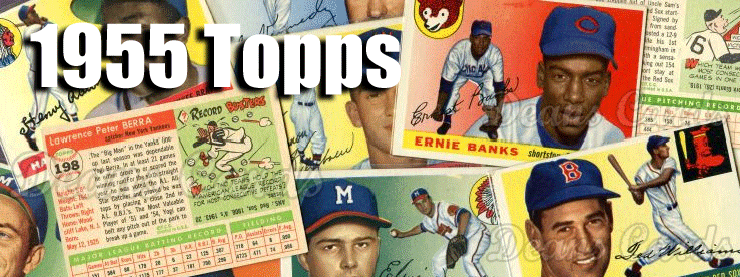The 1955 Topps set is also printed on the large size cards that measure 3¾” by 2⅝”, but Topps kept their offering fresh by employing a horizontal layout on the front of their cards for the first time. While the 1952 Topps cards featured horizontal backs, Topps never attempted a horizontal front until 1955. Fortunately for Topps, they had learned so much about what card consumers wanted since 1951, that they had enough interesting material to fill the large canvas.

As in 1954, the 1955 Topps baseball cards have two different pictures of the players on each card. A close-up portrait and an action shot set further away, which was an improvement on the idea formulated in 1954. Topps also incorporated a facsimile autograph as they did in their 1954 set. Topps continued the use of the Major League logos, which had become a unique signature of their sets. This was a concept that Bowman never adopted. The 1955 Topps can be distinguished by the panel at the bottom, which features the players’ name, position, and team.
Losing the contract battle, but winning the war
The entire 1955 Topps baseball card set consists of only 206 cards. Although Bowman was losing the gum card war in terms of sales, they were actually winning the battle for exclusive contracts with the players. As a result, Mickey Mantle, Whitey Ford, and Bob Feller are conspicuously absent from the 1955 Topps set.
By 1955, the battle lines in the Great Baseball Card Gum War were stabilizing and as a result only 41 players appeared in both the Topps and Bowman baseball card sets. Only 144 players appeared exclusively on the 1955 Topps cards, while a record 210 players appeared exclusively in the Bowman set. Topps had already printed cards for some players who signed with Bowman in the 1955 set, just as they (Topps) had done in 1953. As a result, four numbers from the 1955 Topps set were never issued: Cards numbered 175, 186, 203 and 209.

There are no major variations in the 1955 Topps set, making it somewhat easier to collect. However, 1955 Topps does include a high number series (#161-210) that is more expensive than the low number series. Duke Snider (#210) is particularly difficult to find; it was the very last card issued by Topps in 1955 and is known to have centering and condition issues.
Topps again has better rookie cards
Another reason the 1955 Topps set is popular with today’s collectors is the three rookie cards of future Hall-of-Fame players that can be found in this set: Sandy Koufax (#123), Roberto Clemente (#164) and Harmon Killebrew (#124). Unlike the Topps Rookie Class of the previous year, the performance of these rookies would not be a factor in card sales in 1955. The reason was that none of these three players were considered any more than prospects with raw potential in 1955 and none would become stars for at least another four years.
Results
Topps was on a roll. Just one year after they issued their first set of baseball cards with dual images, Topps built on their momentum and took their 1955 set to the next level by including not one, but two color player images on the card fronts.
 The result was that collectors again preferred the exciting and attractive Topps cards over the Bowman issue, and Topps sold more cards for the fourth consecutive year. Although few collectors realized it at the time Bowman had lost money each of those years and their losses had reached a critical point.
The result was that collectors again preferred the exciting and attractive Topps cards over the Bowman issue, and Topps sold more cards for the fourth consecutive year. Although few collectors realized it at the time Bowman had lost money each of those years and their losses had reached a critical point.This article is taken from Dean’s book “The Gum Card War and the Great Bowman & Topps Baseball Card Sets of 1948-1955”, which is now available for sale at Amazon.com.
Dean Hanley is an authority on vintage sports cards and has written numerous articles on the topic. Mr. Hanley is the founder DeansCards.com, and with well-over one million vintage cards in inventory, DeansCards.com is the largest seller of vintage cards on the web. Dean has also published “Before there was Bubble Gum: Our Favorite Pre-World War I Baseball Cards”, which is also available in eBook form at Amazon.com and has just released a T207 reprint set. For more information, please visit www.DeansCards.com
If you are looking to sell your cards we would be happy to hear from you. Please fill out our sell your collection form here and we will be in touch.


No comments:
Post a Comment